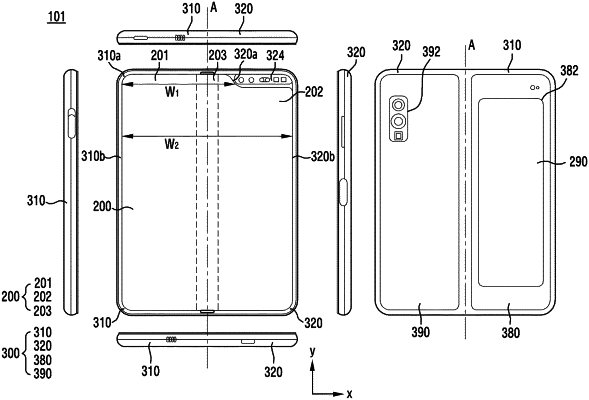| CPC G09G 5/14 (2013.01) [G06F 1/1641 (2013.01); G06F 1/1681 (2013.01); G06F 3/041 (2013.01); H04B 1/3827 (2013.01); H04M 1/0268 (2013.01); G09G 2340/0407 (2013.01); G09G 2354/00 (2013.01); G09G 2380/02 (2013.01)] | 18 Claims |

|
1. An electronic device, comprising:
a first housing including a first face, and a second face opposite the first face;
a second housing including a third face, and a fourth face opposite the third face;
a hinge connecting the first housing and the second housing, wherein the second housing folds about the hinge to face the first housing;
a flexible display extending from the first face to the third face;
a display exposed through the second face;
a sensor circuit configured to sense a change in a physical state between the first housing and the second housing folding at the hinge; and
a processor operatively connected to the flexible display, the display and the sensor circuit,
wherein the processor is configured to:
while an application is being executed, detect the change in the physical state of the first housing and the second housing based on the sensor circuit, wherein the physical state includes a first state in which the first housing and the second housing are folded onto each other or a second state in which the first face of the first housing and the third face of the second housing face a same direction,
determine whether the application being executed supports a resolution change when the change of the physical state is detected,
in response to the application not supporting the resolution change when the change of the physical state is detected, re-execute the application, and
in response to the application supporting the resolution change when the change of the physical state is detected, change a resolution of an execution screen of the application, and
wherein re-executing the application comprises:
determining a type of the application being executed based on whether the application being executed supports an automatic screen rotation function, wherein the type of the application includes a first type in which the resolution of the execution screen of the application is changed based on a first predetermined resolution and a second type in which the resolution of the execution screen of the application is changed based on a second predetermined resolution, wherein the first predetermined resolution includes a resolution at which the execution screen of the application is output without a blank space on the flexible display or the display on which the execution screen of the application is to be output based on a size of the flexible display or the display and the second predetermined resolution includes a resolution at which the execution screen of the application is output having the blank space on the flexible display or the display on which the execution screen of the application is to be output based on an aspect ratio of the flexible display or the display,
when the application being executed is the first type of application, re-executing the application so that the resolution of the execution screen of the application is output at the first predetermined resolution when sensing a resolution change event, and
when the application being executed is the second type of application, re-executing the application so that the resolution of the execution screen of the application is output at the second predetermined resolution when sensing the resolution change event.
|